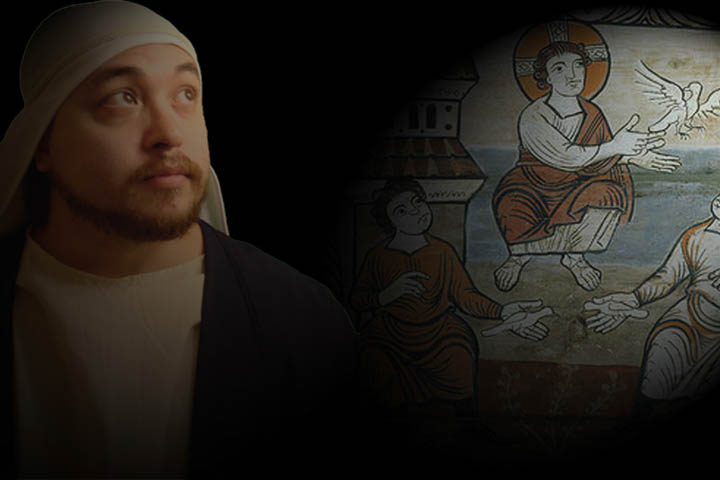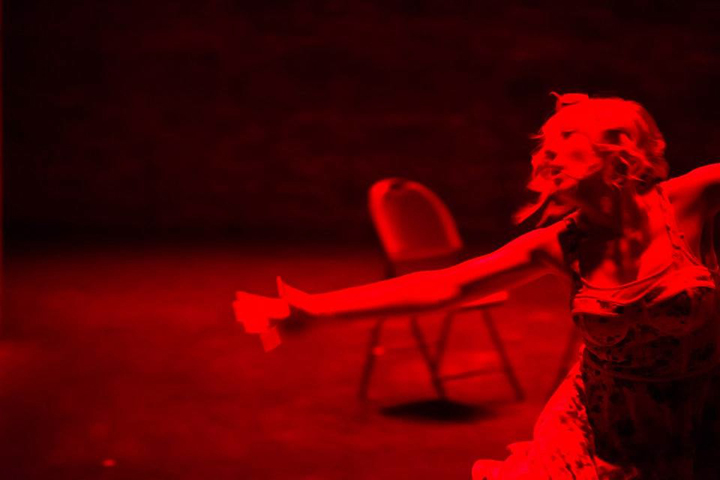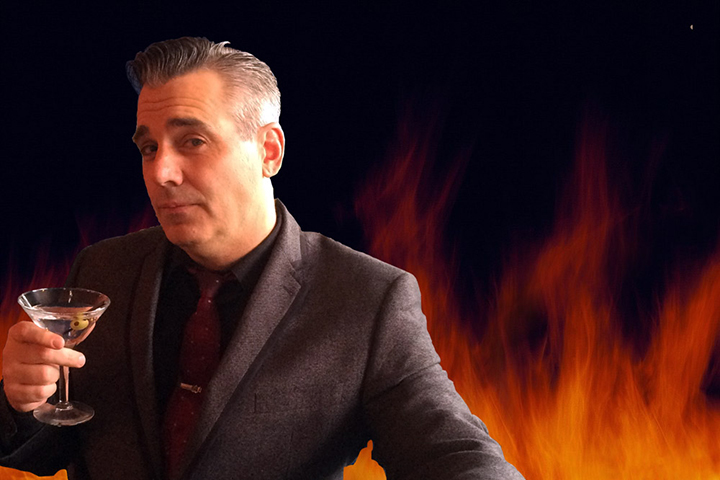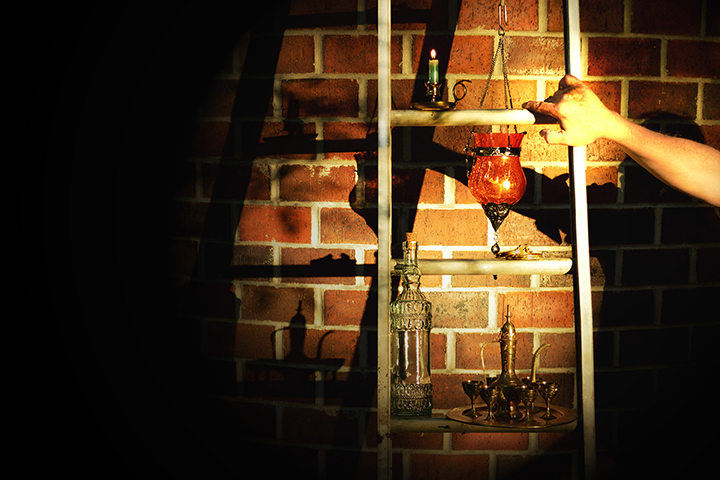Getting to Know the Fringe in a Biblical Way
Mn Artists' editor reports back after a full evening of shows wrestling with angels, coming to Jesus, making deals with the devil and laying down the Good Word.

I got to know the Fringe Wednesday night in a biblical way – four shows’ worth of wrestling with angels and deals with the devil, reckoning with mortal sin, and laying down the Good Word. I’m struck by the sheer number of productions on such themes in this year’s festival line-up. Something in the zeitgeist, maybe?
I start the night in Northeast Minneapolis, at the Ritz. The crowds are thinner midweek than on the weekends, and I find myself in line with the Fringe faithful – lots of fancy Ultra Pass lanyards, artists taking advantage of their festival passes between shows, and diehards showing off suspenders filled with Fringe buttons from festivals past.
I pick up a ticket from the box office to see phillip andrew bennett low’s latest storytelling work, The Secret Book of Jesus. (I should note: low and I have a friendly working relationship, as he’s contributed essays and reviews from time to time for us over at Mn Artists.) The Ritz studio is intimate, and the space is simply set: just a stand from which to read and a low table holding a pitcher of water and a glass of wine. Low steps up to the stand without fanfare or costume. (The Old Testament beard he’s sporting is a nice touch, though, and new since I saw him last.) There’s a delicious audacity to the task low has set for himself with this show: he’s weaving together an assortment of apocryphal tales to do with Jesus’s early life, drawn from various gnostic gospels and early Christian folktales. And he does so with laudable theological and literary rigor. By low’s telling (and in keeping with current scholarship), the messiah is more firebrand than lamb. Even as a baby, his Jesus is irascible, sometimes punitive in his righteousness, as quick to deal in death as he is in resurrection or redemption. Low deftly exploits hidden-in-plain-sight narrative fissures in familiar New Testament stories – and he fills those gaps with, say, behind-the-scenes exploits of Jesus and the apostles in hell, post-crucifixion; or with the interpersonal particulars of Mary’s unorthodox marriage to Joseph and what happened to the midwife who attended the Virgin Mother’s immaculate birth. Throughout, Low’s delivery is pitch-perfect for the material: equal parts prophet, bard, and snake oil salesman. The writing is smart, cleverly toeing a shifting line between straight exegesis and pure fancy. He’s a playful storyteller, downright hammy sometimes, and his flair for showmanship serves nicely to leaven the dense language and subject matter of his material. It’s a bracing alternative to the sillier stuff on offer, and funny and engaging, to boot. This sort of thing is not going to be everyone’s bag, granted, but if your interest is piqued, I wholeheartedly recommend that you go.

Next up, I hit the Ritz proscenium stage for a dance-meets-spoken word collaboration, loosely themed around the seven deadly sins: Dance with the Devil by Erin Sheppard Presents. The dance portion isn’t particularly innovative, but it’s crowd-pleasing – slick, hip hop choreography against a thumping backbeat of rap and pop paired with narrative-heavy movement vignettes dealing with loss, envy, violence, and the lure of darkness. The dancers are capable and the individual pieces polished, but there is a self-conscious moodiness to the movement sequences, an affected darkness enacted in the pairings’ interactions, that’s laid on a bit thick for my taste. Self-contained spoken word pieces, contributed by improviser and actor Rita Boersma , took the stage between each short dance number. Boersma’s demeanor on stage is charming and candid: she offers a series of dryly funny, first-person stories, mostly feel-good riffs on the seven deadly sins. She tallies a delightful range of youthful transgressions and anxieties – her childish confessional checklists and unlikely tween lust, the vanities that follow adolescent insecurity. Boersma’s turns on stage are mostly breezy good fun (but for a memorable, heartfelt and sad story about her brother’s addiction). Taken together, I’m not sure what to make of the combined package here, to be frank with you. I’m glad there’s room in the Fringe Festival for such cross-pollinations, but it’s hard to imagine quite who they’re going for with a hybrid like this.

I made my way from the Ritz to Theatre in the Round next, for Ante-Deluvian Productions’ Hope You Guess My Name. Writer and actor Ari Hoptman, known for his reliably snappy dialogue and comedic chops, penned the script. The small ensemble of players is well cast to make the most of the writing’s wry sensibilities: actor Eric Webster makes a perfectly smarmy Prince of Darkness; Shanan Custer and Hoptman, likewise, play his ensnared marks with daffy aplomb. Other festival favorites, like Joshua Scrimshaw, Levi Weinhagen, Steve Lattery, and Katie Adducci, ably round out the supporting roles. The humor throughout is broad but clever, consistently delivered with great timing and verve. You know the bones of the story already, no doubt: a couple of saps, unhappy with their lots in life, meet up with the Devil, who offers them a diabolical bargain. In Hoptman’s version of the well-worn story, there’s a mixup with the paperwork and legal hijinks ensue – but plot particulars are beside the point, really. Hope You Guess My Name is a confection, and it wears a wink to the audience on its sleeve from the get-go. You don’t see a Fringe show like this for dramatic heft or moral nuance. You go for cleverly won laughs – and, in that, you won’t be disappointed.

I finished the night back at the Ritz, with Only a Dim Image Theatre’s original production, Jacob’s Ladder. It’s an elaborate, overtly devotional, song-and-dance retelling of the Genesis stories about Jacob. It’s not a provocative interpretation of the scriptures; indeed, the rough, nasty bits of the Old Testament source material have all been worn smooth and made safe. The spoken elements amount to little more than perfunctory scripted bits of dialogue intended to supply minimal exposition and dialogue which can serve as scaffolding for Cecil B. DeMille-inspired song and dance numbers. A number of rough-hewn ladders on stage anchor the dramatic and dance interplay among the small ensemble. Performers leap and sway across the stage balletically between scenes. The choreography is self-consciously pretty: the young women seem strategically posed in attractive tableaux; gold-toned bunting is twined above and between them, like aerial silks turned sideways. A curtained scrim sits at stage left, behind which backlit performers, visible only in silhouette, occasionally move the action of Jacob’s tale forward: wrestling angels, enacting chaste love scenes and, at opportune times, dramatically scaling footstools. To my chagrin, tambourines made an appearance at one point.
Look, there’s no lack of raw talent here: the two lead vocalists (in the roles of Jacob and Rachel), in particular, stand out as musicians with real promise. The production as a whole was plainly well-practiced and earnest (excruciatingly earnest) in its objectives. Nonetheless, the target audience for this kind of fare strikes me as both niche and self-selecting.
It’s funny. The relatively arbitrary way I went about selecting shows this time around strangely made for a better-than-usual representative sampling of what’s on offer at the festival. It was freeing, too, not to try and seek out the “best” shows, or the ones with known players, but offered a little more agency in the choosing than a toss of the dice.
Editor’s note: This piece is published in partnership with Minnesota Playlist, with whom Mn Artists is teaming up this year to cover the Fringe.
Susannah Schouweiler is a writer, arts critic, and Editor-in-Chief of Mn Artists, an artist-driven, online media platform based at the Walker Art Center covering the art and artists of the Midwest.